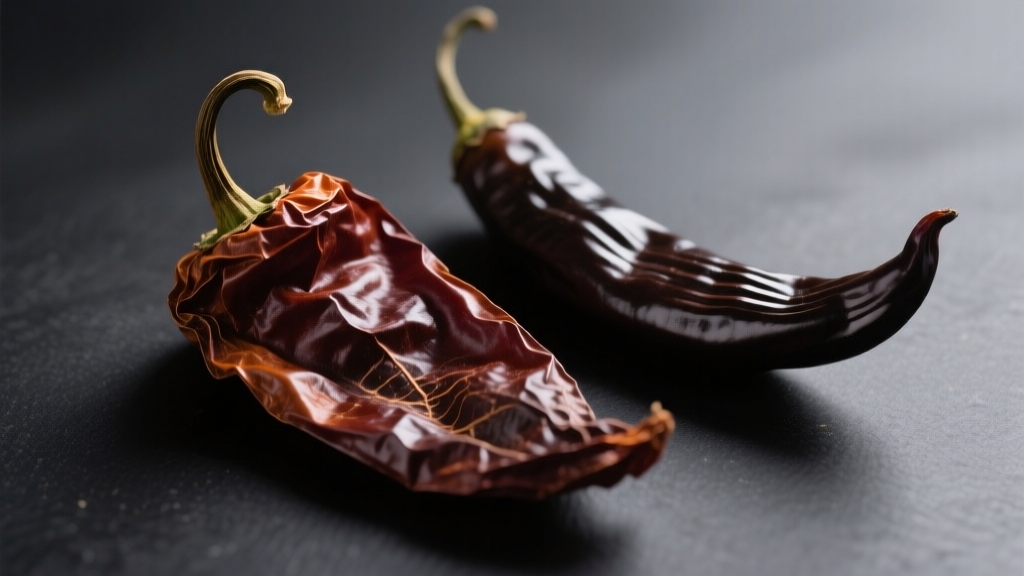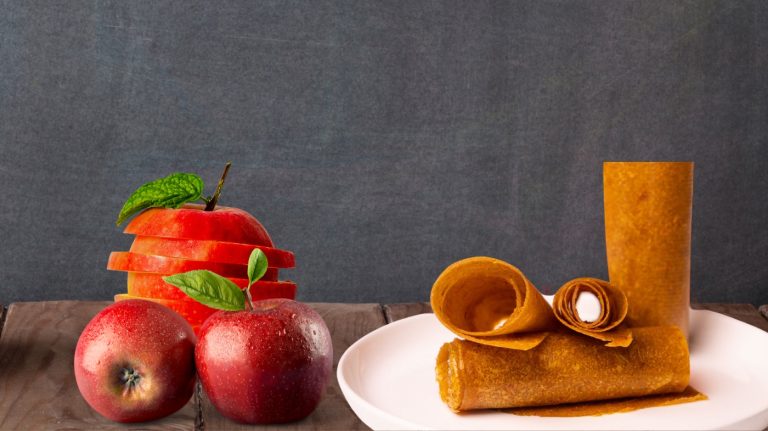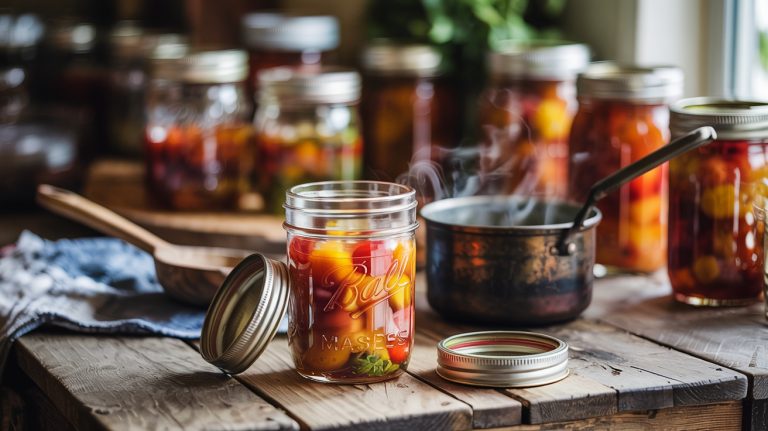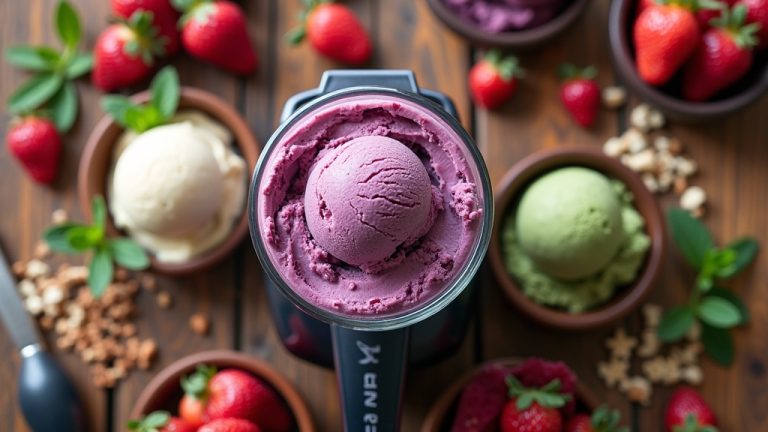Chile Ancho vs Chile Pasilla: Which Pepper Wins?
When you choose chile ancho, expect a mild heat with sweet, fruity notes reminiscent of dried cherry and cocoa. Chile pasilla, however, brings a richer, earthier flavor with smoky undertones and a slightly sharper heat.
Anchos are broad and flat, while pasillas are slim and wrinkled, often mistaken for one another. Both enhance dishes differently, shaping authentic Mexican flavors in unique ways. Keep exploring to uncover how each transforms your recipes.
Key Takeaways
- Chile Ancho is broad, heart-shaped, mild with sweet, fruity, and smoky flavors, while Pasilla is slim, wrinkled, and earthier with deeper smoky and raisin notes.
- Ancho peppers are dried ripe Poblanos, offering 1,000–2,000 SHU heat; Pasillas are hotter, ranging up to 2,500–4,000 SHU.
- Ancho is preferred for mole sauces and mild dishes; Pasilla suits bold sauces, soups, and smoky regional specialties like Pasilla de Oaxaca.
- Pasilla chiles are often confused with ancho due to labeling but differ significantly in shape, heat, and flavor complexity.
- Chefs choose Ancho for gentle warmth and sweetness, and Pasilla for a more pronounced, earthy heat and rich flavor depth.
Chile Ancho Pepper vs Chile Pasilla: Complete Side-by-Side Guide
| Aspect | Chile Ancho | Chile Pasilla |
|---|---|---|
| Heat Level | 1,000-2,000 SHU (Mild) | 2,500-4,000 SHU (Mild to Medium) |
| Flavor Profile | Sweet, fruity with cherry and cocoa notes | Earthy, smoky with coffee and raisin undertones |
| Fresh Pepper Origin | Dried Poblano pepper | Dried Chilaca pepper |
| Physical Shape | Broad and heart-shaped (3-4 inches long) | Slim and wrinkled (6-8 inches long) |
| Color | Dark reddish-brown to purplish | Deep brown to black |
| Primary Uses | Mole poblano, enchilada sauces, marinades | Sauces, soups, chiles rellenos |
| Regional Preference | Central and Southern Mexico | Oaxacan cuisine, traditional moles |
| Texture When Dried | Pliable and flexible | Wrinkled and leathery |
| Substitution Factor | Can replace pasilla with milder results | Can replace ancho with spicier kick |
| Storage Life | 2-3 years in airtight containers | 2-3 years in cool, dark places |
| Rehydration Time | 15-30 minutes in hot water | 20 minutes with gentle handling |
| Best Cooking Methods | Grinding, stuffing, sauce making | Blending, roasting, paste creation |
Flavor Profiles and Heat Levels
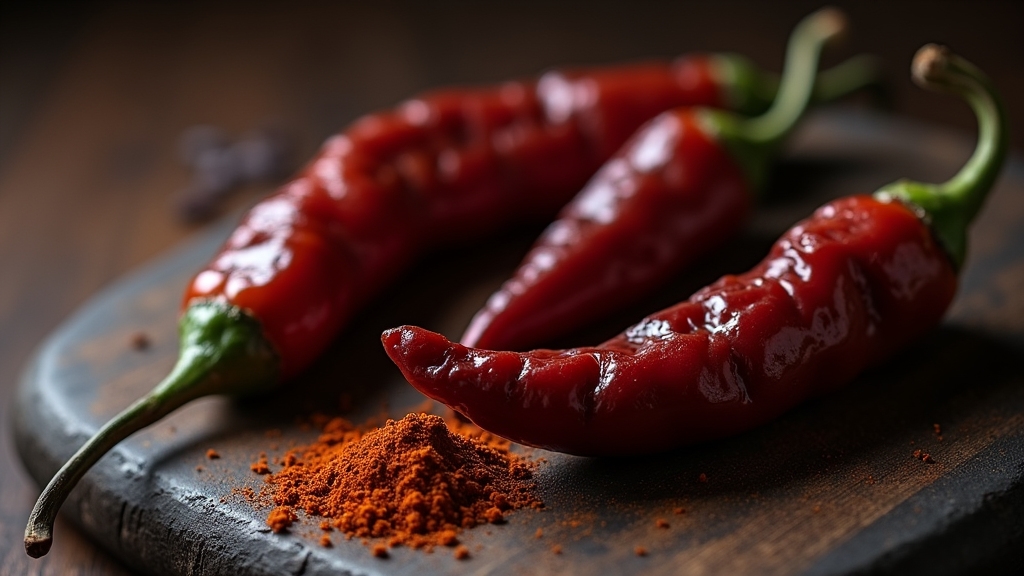
While both chile ancho and chile pasilla bring mild heat to the table, their flavor profiles set them apart distinctly. You’ll find ancho chiles offer a sweet, fruity taste with hints of dried cherry, cocoa, and mild chocolate, complemented by subtle smoky and tea notes.
The ancho is the dried version of the poblano pepper, which is fresh and green before drying, giving it its characteristic heart-shaped form. To ensure the best flavor retention when cooking, using proper techniques like preventing leaks in cookware can be crucial.
Pasilla chiles, on the other hand, deliver an earthy, smoky flavor with coffee-like richness, berry nuances, and a raisin-like finish, often slightly sweeter and fruitier overall.
In terms of heat, ancho peppers range from 1,000 to 2,000 SHU, providing gentle warmth, while pasillas can reach up to 2,500 SHU or more, offering a sharper, more pronounced heat.
Both peppers contribute layered complexity to dishes, with ancho brightening and pasilla deepening flavors beautifully.
Physical Characteristics and Botanical Origins
When you hold an ancho chile, you’ll notice its large, broad shape measuring about 3 to 4 inches long and up to 2.5 inches wide, with dark reddish-brown to purplish skin that’s wrinkled yet still plump and slightly flexible.
This wide form, which gives ancho its name meaning “wide,” comes from drying fully ripened Poblano peppers. Botanically, ancho chiles belong to the Capsicum annuum species and start as fresh, green Poblanos that mature to a bright red before drying.
Originating in Puebla, Mexico, Poblanos have been cultivated since pre-Aztec times. The drying process enhances their mild heat and rich, fruity aroma, yielding a pepper that’s pliable rather than brittle.
Anchos are closely related to Mulato chiles but differ mainly in color and subtle flavor nuances. They are primarily cultivated for flavor rather than heat, making them a mild chile variety.
Culinary Applications and Regional Varieties
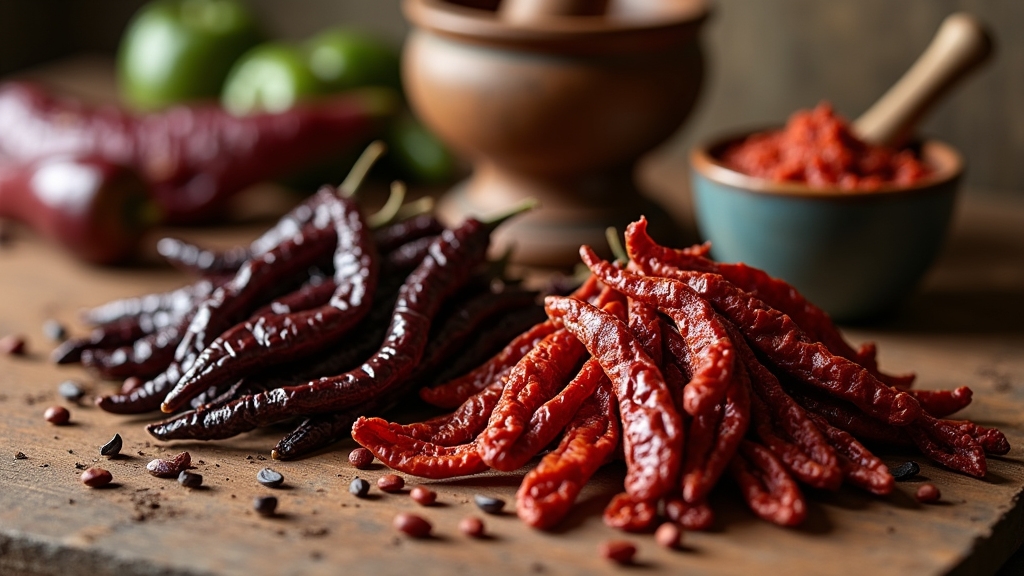
Although ancho and pasilla chiles share a place of honor in Mexican cuisine, you’ll find they each bring distinct flavors and uses to the table. An ancho chile, with its sweet, smoky profile, enriches mole poblano, enchilada sauces, and even desserts like chocolate brownies.
You’ll often see it ground into powders or pastes for marinades and rubs, especially in central and southern Mexico. Pasilla, on the other hand, offers earthy, mild heat and shines in sauces, soups, and as a stuffing for chiles rellenos.
Its regional smoked variant, Pasilla de Oaxaca, adds deeper spice and smoky notes ideal for salsas. Whether dried, roasted, or rehydrated, both chiles shape regional dishes, reflecting their unique culinary identities across Mexico.
Both chiles provide unique flavor profiles that are essential to creating authentic Mexican dishes. Like choosing the right kitchen elements, understanding the importance of design harmony in flavors enhances the overall culinary experience.
Common Misidentifications and Market Confusions
Because ancho and pasilla chiles look somewhat similar and share overlapping uses, you’ll often find them mislabeled in grocery stores and online markets.
Anchos, being broader and heart-shaped, are easier to spot, but pasillas’ slim, wrinkled form often gets mistaken for ancho or even other chilies. Pasilla chiles tend to be slightly hotter than anchos, with heat levels reaching up to 4,000 on the Scoville scale, which can affect the spiciness of dishes if confused.
Proper cooking tools with efficient heat distribution can help manage the delicate cooking process when using these chiles. Ancho and pasilla chiles often get mixed up due to their similar looks and shared culinary uses. Vendors sometimes swap images or mix descriptions, adding to confusion.
Packaging and labeling don’t help much either—some brands lump both under vague “dried chili” tags or use regional names inconsistently. You might also see blends without clear proportions, blurring lines further.
If you’re shopping outside Mexico, pasillas are rarer and often unfamiliar, leading to more mix-ups. Paying close attention to shape and source can help you avoid these common market misidentifications and ensure you select the chile with the desired flavor profile.
Distinctive Features and Chef Preferences
While ancho and pasilla chiles both bring mild heat and rich complexity to dishes, their distinctive flavors and textures shape how chefs choose to use them. You’ll find ancho favored for its sweet, smoky, and fruity notes, perfect when you want gentle heat and a broader, flatter shape ideal for stuffing.
Its heat level is mild, typically ranging from 1,000–2,000 SHU, which provides balanced sweetness without overpowering spice. Chefs often consider the chile’s overall design fit in a dish to ensure it complements other flavors without overwhelming them.
Pasilla, with its earthier, raisin-like flavor and slightly higher heat, often appeals to chefs crafting bold moles or robust meat marinades, especially in Oaxacan cuisine. You might notice pasilla variants like Pasilla de Oaxaca adding smoky spiciness, which ancho lacks.
Pasilla’s complexity arises from pyrazine compounds that contribute coffee and cocoa flavors, making it essential for dishes requiring deeper, more robust profiles.
Though sometimes interchangeable, chefs rely on ancho’s mild sweetness versus pasilla’s deeper, more savory profile to maintain authenticity. So, whether you’re blending sauces or preparing rellenos, understanding these differences guides your best chile choice.
Frequently Asked Questions
How Should Ancho and Pasilla Chiles Be Stored to Maintain Freshness?
You should store ancho and pasilla chiles in airtight glass jars, preferably amber or green to block UV light. Keep them in a cool, dark place between 60-72°F, away from heat and moisture.
Use silica gel packets to control humidity and avoid refrigeration unless using soon. Freeze whole chiles for long-term storage. Always store them whole and grind only what you need to keep their flavor fresh and vibrant.
Can Ancho and Pasilla Chiles Be Substituted for Each Other in Recipes?
Think of ancho and pasilla chiles as two characters in your culinary story—each brings a unique voice. You can substitute one for the other, but expect a shift in flavor: pasillas add fruity heat, while anchos offer smoky sweetness.
Use equal amounts but adjust for pasilla’s spicier punch. In dishes like mole or stews, swapping works well, but when chile flavor leads, blending both may keep your recipe’s harmony intact.
What Are the Best Methods for Rehydrating Dried Ancho and Pasilla Chiles?
To rehydrate dried chiles, start by removing stems and seeds, then lightly toast them to boost flavor. Soak ancho chiles in hot water for 15-30 minutes until soft and sweet.
Pasilla chiles need gentler toasting and about 20 minutes soaking to prevent bitterness. Keep the soaking liquid as it adds depth to your sauces. Handle pasilla carefully to avoid tearing, and blend or chop after soaking for rich, flavorful dishes.
Are Ancho and Pasilla Chiles Safe for People With Nightshade Allergies?
If you have a nightshade allergy, you shouldn’t eat ancho or pasilla chiles—they belong to the same family and can trigger severe immune reactions. Both contain similar proteins and alkaloids that your immune system might attack.
Even if you just have sensitivity, these chiles could still cause discomfort. It’s best to avoid them and consult an allergist to confirm your allergy and explore safe alternatives for flavor in your cooking.
How Long Do Dried Ancho and Pasilla Chiles Typically Last Unopened?
Think of unopened dried ancho and pasilla chiles as time capsules—they typically last 2 to 3 years if you store them right. Keep them tucked away in a cool, dark, and dry spot inside airtight containers to lock in their flavor.
While some claim they can last even longer, their potency and aroma will start to fade, so it’s best to use them within that window for the freshest taste.
Ready to Master These Mexican Peppers? Unlock Authentic Flavors
When you choose between chile ancho and chile pasilla, think of them as two colors on a spice palette, each bringing its own unique shade to your dish. Chile ancho offers a mild, sweet warmth, while chile pasilla delivers a deeper, smoky complexity.
Knowing their differences helps you paint bold and flavorful culinary masterpieces. So, next time you cook, let these chiles guide your hand and elevate your flavors with confidence and creativity.

